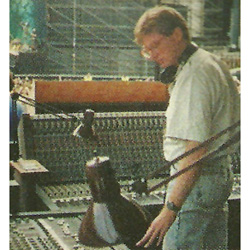
Dave D: The plasma meters with the switchable display were so trick!
Bruce: Yes. This was the first console of any type to use plasma meters. These were made by Burroughs and were also unique in that when they scanned. One scan would represent the average level and the next scan would represent the peak. The result was you saw two displays over-layed on top of each other, and it was really easy to track down hums, buzzes and noises because you could see the energy by comparing the average and the peak response. We built the same feature into the new DSP project.
Moderator: OK… let’s turn our focus to the more present time. Bruce, can you briefly explain to us your early interest in the possibilities of digital technology for audio applications?
Bruce: OK. I was interested really early in the piece and convinced Clair Bros into buying a Digital Equipment Corp. computer. That was my first computer experience. Fairlight had developed the first digital audio sampler. Fairlight consisted of two friends from Australia who didn’t have any contacts in the music business, so I helped them promote their ground breaking product by sticking it in the back of my plane and flying all over the country, trying to convince someone, anyone to buy it. That’s where I really saw how you could do things in digital that you couldn’t even think of doing in analog. That was in 1978 after Bruce Springsteen’s Darkness Tour.
Douglas Carmichael: What model/type of DEC computer?
Bruce: It was a PDP 11 with cassette storage!
Jeff Harris: Hi Bruce. I’m rebuilding an old Fairlight IIx now!
Bruce: Hi Jeff. Jeff traveled around the country with me after his boss, Geordie Hormell, became the distributor for Fairlight. Geordie is the same Hormell as on the Spam can and owns The Village Recorder in West Los Angeles.
Dave D: I remember Fairlight saying “We went from being the world’s most expensive sampler, to being the world’s cheapest multitrack recording studio.”
Bruce: I don’t know that it was really all that cheap. I still have have the first check from the first sale (copy) signed by Stevie Wonder with his thumb print! The check was for $27,500. You should have seen the expression on the [bank] tellers face in Lititz, when I went to cash it!
Moderator: Moving on to the Lake Countour…
Bink: Did anybody ask yet about the new Mesa EQ curve and the related Raised Cosine? I’m interested in whether the phase response is choppy or jagged—whether there is any downside their shapes.
Bruce: By the way, I’ve asked my friend, David McGrath, to be on-line with me for moral support.. In answer to your question, the phase response is incredibly smooth, and the parametric EQ and graphic EQ has a minimum phase response. There is no downside at all to these new shapes. Dave has come up with an amazing piece of math that synthesizes any shaped curve you can define mathematically, or completely arbitrarily.
David McGrath: Yes, we have found that minimum-phase responses sound better in most situations. Also, when graphic bands are stacked side-by-side, their phase responses ‘blend’ with each other smoothly.
